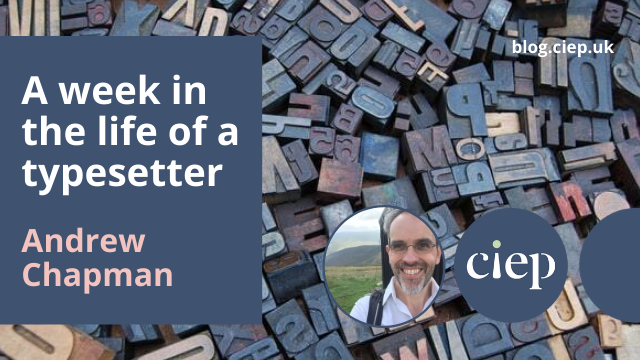I’ll have to begin with a disclaimer: a lot of each ‘week in my life’ is currently spent as a (very) amateur home-based teacher of my two children, something I’m sure many CIEP members in the middle years of life can relate to; so this blog post instead reflects some of the variety of my work. ‘Typesetting in times of change’, perhaps!
 A flexible approach
A flexible approach
It was luck that brought me to my slightly unusual career, mixing editorial and writing work with the design side of publishing. Early in my career, I got a job as a staff writer on a computer magazine – remember the Amstrad PCW word processors? That technology was already obsolescent in the mid-1990s, but in a sense this helped me out: the magazine had a small team, so learning fast on the job, and being able to pick up how to use QuarkXPress, was an asset. A later stint on a weekly newspaper, again requiring a flexible approach, cemented my combination of editing and typesetting skills, which has kept me fed as a freelancer for more than 20 years now.
I’d say the two things that have changed the most in that time have been the software and the route to publication, which are inevitably intertwined. Quark is often forgotten these days, as most publishers use Adobe InDesign – though actually I still prefer Quark myself, and its current version is a worthy competitor once again. In practice I use both most days – although editing work is still done in Word.
Changing technology
The advent of self-publishing has had a major influence on the technology – all routes for print lead to a press-ready PDF, but ebooks have very different constraints and attributes. The holy grail of publishing is a system which is flexible, easy to use and accommodates these very different forms of output from a single source file. Both Quark and InDesign can produce ebooks, but I find they are not always very good – it depends on the book. And now there are various solutions in the mix which can sometimes make all this a simpler business – I’m thinking of Vellum (a Mac-only program which is very clever, but limited in its typesetting features), Pressbooks and other tools created by marketplaces such as Reedsy and Amazon. A new player in the print-and-ebook space is Hederis – too pricey for my taste, but one to watch.
The point of this trip down software’s memory lane is really that one has to keep up with these trends, and expect to use a variety of tools for the job – the varied nature of books and magazines means that no single tool cracks every nut. But the one thing that is guaranteed to have any typesetter in tears is a file in Microsoft Publisher format!
Varied work
Much of my career has been spent in magazines, but over the last few years I have shifted the balance of my business to books – sadly magazines seem to be in serious decline, apart from a niche market for attractive indie magazines, often marketed online. Inevitably shop closures during the pandemic have accelerated the decline of the newsstand, although the more serious enemy really is the vast range of free content online. Thankfully, books seem to be thriving, and in the lockdown months I’ve noticed a lot of authors seem to be finishing their books and looking for help in getting them out.
Being an editor who typesets, or a typesetter who edits – my sense of which I am varies day to day – means I can often be involved through more of a book’s production, which I find very rewarding. I find the two activities occupy very different parts of my ‘headspace’, too: for editing, I have to be working in absolute silence, but I can work on paper or a laptop if need be; whereas for typesetting, I typically have Radio 4 burbling in the background – I have two large screens in front of me, and now can’t remember how I ever managed with one.
I love the variety of projects which freelancing enables me to take on – although the scheduling can of course be a headache, especially when books get delayed or all suddenly come in at once. One recent project which I enjoyed being involved with was a lockdown cookery book by a Michelin-starred chef, whose son grew the vegetables the chef cooked with – so it was an interesting mix of father-and-son bonding and mouth-watering recipes, accompanied by amazing photos by a professional food photographer.
 I’m something of a generalist by nature – hence the two sides to my career, I suppose – so I also enjoy not knowing what’s next: my most recent editing projects have been a historical novel, a thesis about forensics in detective fiction and a book about understanding canine psychology; and on the design side there have been business books, a short story collection and a trio of books by an established author dipping her toe in the world of self-publishing for the first time.
I’m something of a generalist by nature – hence the two sides to my career, I suppose – so I also enjoy not knowing what’s next: my most recent editing projects have been a historical novel, a thesis about forensics in detective fiction and a book about understanding canine psychology; and on the design side there have been business books, a short story collection and a trio of books by an established author dipping her toe in the world of self-publishing for the first time.
If there’s one subject area I particularly enjoy, however, it’s history – I’ve been the editor of a family and social history magazine for the last decade, and these days I typeset it too (of course, sometimes budgetary constraints lurk behind these decisions). And in December, I launched a related side project of my own – a weekly email newsletter presenting first-hand accounts from history, partly because I feel history publishing needs more ‘ordinary’ voices from the past rather than just famous names and royalty. I’m not really sure why I’ve forced more constraints on my complicated week – but I suppose if there’s one thing my erratic career has shown, it’s that I like a challenge.
Working together
Maybe being an editor/typesetter combined is ultimately my real specialism – hopefully I’ve got enough years under the belt now to have some insight into how the two work best together, and I’ll try to suppress the lingering spectre of imposter syndrome that whispers ‘jack of all trades, master of none …’ in my ear.
From a typesetter’s point of view, perhaps a few words of advice might be of help to other editors and the authors they work with:
- Please don’t embed images in your Word document – or, at least, only do so for reference. Word has a habit of chewing up image files, and in any case, the typesetting process, regardless of the software used, needs images as separate files. (This isn’t necessarily the editor’s responsibility, of course, but they should always be high resolution, ie at least 300dpi.)
- It’s fine – and indeed helpful – to mark up a Word file with styles, for example for body text and different levels of headings, though try to avoid vast numbers of them; and don’t assume that what falls in a certain way in the Word file will end up looking quite the same in the typeset file.
- Don’t bother ‘laying out’ a book in Word, with running headers and footers, indents or paragraph spacing, and so on: all this will be lost or changed anyway. When a Word file is imported into InDesign, say, the distinctions between styles can be preserved as well as formatting such as bold and italics, but most other things are likely to change. Ultimately the key thing is that the file distinguishes things semantically: the content is sacred, but the form will change.
 Andrew Chapman is a Professional Member of the CIEP, as well as a member of the Publishers Association, the Alliance of Independent Authors, the Society of Authors and the Independent Publishers Guild. When not joining associations, he runs Prepare to Publish with the help of some fellow freelancers. His latest side project, the Histories newsletter, can be found at www.gethistories.com
Andrew Chapman is a Professional Member of the CIEP, as well as a member of the Publishers Association, the Alliance of Independent Authors, the Society of Authors and the Independent Publishers Guild. When not joining associations, he runs Prepare to Publish with the help of some fellow freelancers. His latest side project, the Histories newsletter, can be found at www.gethistories.com
Photo credits: letters by Amador Loureiro; spinach by Sigmund, both on Unsplash
Posted by Abi Saffrey, CIEP blog coordinator.
The views expressed here do not necessarily reflect those of the CIEP.
